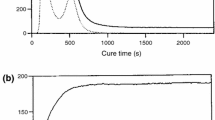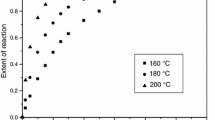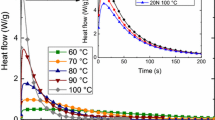Abstract
The cure characteristics of a series of powder coatings containing titanium dioxide dispersed in an epoxy/polyester matrix are reported. The titanium dioxide pigments were produced via both the chloride and sulfate routes and coated with varying amounts of alumina and silica. Comparison data for formulations containing zinc oxide and silica are also included. The time to gelation for these powder coatings depends on a number of factors. Increasing the level of flow agent significantly reduces the time to gelation. The presence of traces of zinc inhibits cure in the case of the sulfate-based pigments. Varying levels of alumina and silica in the coating on the titanium dioxide coating also influence the time to gelation. Increasing the level of silica on the chloride-based coating increases the time to gelation, whereas in the case of the sulfate based coating the time to gelation is shortened. These differences are attributed to the effects of zinc in the coating and the effectiveness of the dicyandiamide catalysts.








Similar content being viewed by others
References
Harris, ST, In: Robertson, EC (ed.) The Technology of Powder Coatings. Portcullis Press, London (1976)
Howell, DM, In: Sanders, JD (ed.) Powder Coatings: The Technology, Formulation and Application of Powder Coatings, Vol. 1. Wiley, London (2000)
Belder, EG, Rutten, HJJ, Perera, DY, “Cure Characterization of Powder Coatings.” Prog. Org. Coat., 42 142–149 (2001)
Utech, B, A Guide to High-performance Powder Coating. Society of Manufacturing Engineers, Michigan (2002)
Pethrick, RA, Polymer Science and Technology. Whittles Publishing, Caithness, Scotland (2010)
Mafi, R, Mirabedini, SM, Naderi, R, Attar, MM, “Effect of Curing Characterization on the Corrosion Performance of Polyester and Polyester/Epoxy Powder Coatings.” Corros. Sci., 50 3280–3286 (2008)
Entwistle, T, Gill, SJ, “Effect of Titanium-Dioxide Pigments on the Cure of Thermosetting Films.” J. Oil Colour Chem. Assoc., 69 (2) 25–42 (1986)
Weiss, KD, “Paint and Coatings: A Mature Industry in Transition.” Prog. Polym. Sci., 22 (2) 203–245 (1997)
Braun, JH, Baidins, A, Marganski, RE, “TiO2 Pigment Technology: A Review.” Prog. Org. Coat., 20 (2) 105–138 (1992)
Thames, SF, Panjnani, KG, Pace, SD, Blanton, MD, Cumberland, BR, “Novel Organosilane Cross-Linking Agents for Powder Coatings.” J. Coat. Technol., 67 (841) 39–45 (1995)
Panjnani, KG, Pace, SD, Thames, SF, “Correlation of Thermal History and Performance in Thermosetting Powder Coatings.” J. Coat. Technol., 67 (843) 23–27 (1995)
Affrossman, S, Collins, A, Hayward, D, Trottier, E, Pethrick, RA, “A Versatile Method of Characterizing Cure in Filled Reactive Polymer Systems.” J. Oil Colour Chem. Assoc., 72 (11) 452–453 (1989)
Pethrick, RA, Hayward, D, “Real Time Dielectric Relaxation Studies of Dynamic Polymeric Systems.” Prog. Polym. Sci., 27 (9) 1983–2017 (2002)
Affrossman, S, Hayward, D, McKee, A, MacKinnon, A, Lairez, D, Pethrick, RA, Vatalis, A, Baker, FS, Carter, RE, “The Application of the Strathclyde Rheometer to a Variety of Curing Systems.” In: Carter, RE (ed.) Rheology of Food, Pharmaceutical and Biological Materials with General Rheology, pp. 304–314. Elsevier Appl. Sci. Publ. Ltd, London (1990)
Parfitt, GD, “The Role of the Surface in the Behaviour of Titanium Dioxide Pigments.” Croat. Chem. Acta., 52 333–335 (1980)
Garrido, M, Rius, FX, Larrechi, MS, “Multivariate Curve Resolution-Alternating Least Squares (MCR-ALS) Applied to Spectroscopic Data from Monitoring Chemical Reactions Processes.” Anal. Bioanal. Chem., 390 (8) 2059–2066 (2008)
Garden, LH, Hayward, D, Pethrick, RA, “Dielectric Non-destructive Testing Approach to Cure Monitoring of Adhesives and Composites.” Proc. Inst. Mech. E. Part G J. Aerospace Eng., 221 (4) 521–533 (2007)
Hay, JN, O’Gara, P, “Recent Developments in Thermoset Curing Methods.” Proc. Inst. Mech. E. Part G J. Aerospace Eng., 220 (3) 187–195 (2006)
Endruweit, A, Johnson, MS, Long, AC, “Curing of Composite Components by Ultraviolet Radiation: A Review.” Polym. Compos., 27 (2) 119–128 (2006)
Cascaval, CN, Rosu, D, Mititelu-Mija, A, Rosu, L, “Kinetics of the Curing Reaction of Selected Epoxy Resin-Amine Systems.” Polimery, 51 (3) 199–205 (2006)
Cook, MI, Walker, FH, Dubowik, DA, “Recent Developments in Two-Pack Water-Based Epoxy Coatings.” JOCCA-Surf. Coat. Int., 82 (11) 528–535 (1999)
Hamerton, I, Howlin, BJ, “Computer Modelling and Chemical Kinetics of the Cure of Aerospace Resin Systems.” Aircraft Eng. Aerospace Technol., 71 (5) 470–478 (1999)
Yousefi, A, Lafleur, PG, Gauvin, R, “Kinetic Studies of Thermoset Cure Reactions: A Review.” Polym. Compos., 18 (2) 157–168 (1997)
Halley, PJ, Mackay, ME, “Chemorheology of Thermosets—An Overview.” Polym. Eng. Sci., 36 (5) 593–609 (1995)
Bolouri, H, Pethrick, RA, Affrossman, S, “Bonding of a Simulated Epoxy-Resin to Aluminum Surfaces Studied by XPS.” Appl. Surf. Sci., 17 (2) 231–240 (1983)
Egerton, TA, Parfitt, GD, Kong, Y, Wightman, JP, “XPS Analysis of Uncoated and Silica-Coated Titanium-Dioxide Powders.” Colloids Surf., 7 311–323 (1983)
Sham, TK, Lazerus, MS, “X-ray Photoelectron-Spectroscopy (XPS) Studies of Clean and Hydrated TiO2 (Rutile) Surfaces.” Chem. Phys. Lett., 68 426 (1979)
Fisicaro, E, Visca, M, Garbassi, F, Ceresa, EM, “Acid Sites Titration and XPS Analysis of TiO2 Pigments.” Colloids Surf., 3 209–219 (1981)
Rochester, CH, Smith, DG, “Infrared Study of Pyridine Adsorption on Rutile and Silica-Coated Rutile Immersed in Heptane.” J. Chem. Soc. Faraday Trans. 1, 82 2569–2575 (1986)
Ingram, S, Dennis, H, Hunter, I, Liggat, JJ, McAdam, C, Pethrick, RA, Schaschke, C, Thomson, D, “Influence of Clay Type on Exfoliation, Cure and Physical Properties of In Situ Polymerised Poly(methyl methacrylate) Nanocomposites.” Polym. Int., 57 1118–1127 (2008)
Gurino, AA, Rozhkova, YA, Zukal, A, Čejka, J, Shenderovich, IG, “Mutable Lewis and Brønsted Acidity of Aluminated SBA-15 as Revealed by NMR of Adsorbed Pyridine-15N.” Langmuir, 27 (19) 12115–12123 (2011)
Kunmei, S, Zhenhuan, L, Bowen, C, Lei, Z, MaLiang, Z, Jun, M, “The Studies on the Friedel–Crafts Acylation of Toluene with Acetic Anhydride over HPW/TiO2.” Fuel Process. Technol., 92 (10) 2011–2015 (2011)
Cai, C, Wang, H, Han, J, “Synthesis and Characterization of Ionic Liquid-Functionalized Alumino-Silicate MCM-41 Hybrid Mesoporous Materials.” Appl. Surf. Sci., 257 9802–9808 (2011)
Jiao, Z, Mitsuru, K, Yi, W, Nishii, H, Miura, Y, Kamiya, Y, “Changes in Surface Acidity of Silica-Supported Dodecatungstosilicic Acid in Relation to the Loading Amount.” J. Phys. Chem. C, 115 (30) 14762–14769 (2011)
Wischert, R, Coperet, C, Delbecq, F, Sautet, P, “Optimal Water Coverage on Alumina: A Key to Generate Lewis Acid–Base Pairs that are Reactive Towards the C–H Bond Activation of Methane.” Angew. Chem. Int. Ed., 50 (14) 3202–3205 (2011)
Hess, A, Kemnitz, E, “Surface Acidity and Catalytic Behavior of Modified Zirconium and Titanium Dioxides.” Appl. Catal. A Gen., 149 (2) 373–389 (1997)
Kailasam, K, Natile, MM, Glisenti, A, Mueller, K, “Fourier Transform Infrared Spectroscopy and Solid-State Nuclear Magnetic Resonance Studies of Octadecyl Modified Metal Oxides Obtained from Different Silane Precursors.” J. Chromatogr. A, 1216 (12) 2345–2354 (2009)
Pattanaik, M, Bhaumik, SK, “Adsorption Behaviour of Polyvinyl Pyrrolidone On Oxide Surfaces.” Mater. Lett., 44 (6) 352–360 (2000)
Bilgic, C, Yazici, DT, Vural, N, “Characterizing the Surface Acidity of Bentonite by Various Methods.” Surf. Interface Anal., 42 (6–7) 1000–1004 (2010)
Saikia, L, Satyarthi, JK, Srinivas, D, Ratnasamy, P, “Activation and Reactivity of Epoxides on Solid Acid Catalysts.” J. Catal., 252 (2) 148–160 (2007)
Kim, S, Sorescu, DC, Byl, O, Yates, JT, “Perturbation of Adsorbed CO by Amine Derivatives Coadsorbed on the γ-Al2O3 Surface: FTIR and First Principles Studies.” J. Phys. Chem. B, 110 (10) 4742–4750 (2006)
Taylor, H, Chadwick, DL, Law, WC, “Fracture of Epoxy Bonded Dynamic Peel Specimens Containing Interfacial Layers.” Mater. Sci. Technol., 14 524–526 (1998)
Maeda, S, “Surface Chemistry of Galvanized Steel Sheets Relevant to Adhesion Performance.” Prog. Org. Coat., 28 227–238 (1996)
Fitzpatrick, MF, Watts, JF, “Adhesive Bonding of Hot-Dipped Galvanized Steel: Use of ToF-SIMS for Forensic Analysis of Failed Joints.” Surf. Interface Anal., 27 705–715 (1999)
Najari, A, Lang, P, Lacaze, PC, Mauer, D, “A New Organofunctional Methoxysilane Bilayer System for Promoting Adhesion of Epoxidized Rubber to Zinc: Part 1: Optimization of Practical Adhesion.” Prog. Org. Coat., 64 392–404 (2009)
Muller, B, “Organic Corrosion Inhibitors for Zinc Pigment.” Brit. Corros. J., 35 (4) 311–314 (2000)
Gundjian, M, Cole, KC, “Effect of Copper on the Curing and Structure of a DICY-Containing Epoxy Composite System.” J. Appl. Polym. Sci., 75 1458–1473 (2000)
Carter, RO, Dickie, RA, Holubka, JW, Lindsay, NE, “Infrared Studies of Interfacial Reactions of Dicyandiamide on Zinc.” Ind. Eng. Chem. Res., 28 48–51 (1989)
Sreeves, JE, Whitfield, L, “Epoxy-Polyester Powder Coatings—Economic and Technical Considerations in Their Usage.” J. Oil. Colour Chem. Assoc., 62 293–298 (1979)
Bengu, B, Boerio, FJ, “Interaction of Epoxy/Dicyandiamide Adhesives with Metal Substrates.” J. Adhesion, 82 (12) 1133–1155 (2006)
Gaillard, F, Peillex, E, Romand, M, Verchere, D, Hocquaux, H, “Influence of Surface Treatments of Hot-Dip Galvanized Steels on Their Acid–Base Properties and on Their Reactions with some Organic-Compounds.” Surf. Interface Anal., 23 (5) 307–312 (1995)
Lotsch, BV, Schnick, W, “Catalytic Formation and Crystal Structure of Cyanoguanylurea H2NC(=O)NHC(NH2)NCN.” Zeitschrift Fur Naturforschung B J. Chem. Sci., 60 (4) 377–382 (2005)
Acknowledgments
One author (ECT) wishes to thank Tioxide and the EPSRC for maintenance support during the course of this study.
Author information
Authors and Affiliations
Corresponding author
Rights and permissions
About this article
Cite this article
Trottier, E.C., Affrossman, S. & Pethrick, R.A. Rheological studies of the cure of epoxy/polyester powder coatings containing titanium dioxide. J Coat Technol Res 9, 725–733 (2012). https://doi.org/10.1007/s11998-012-9417-7
Published:
Issue Date:
DOI: https://doi.org/10.1007/s11998-012-9417-7




